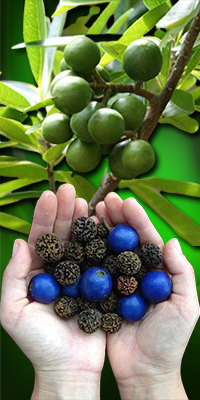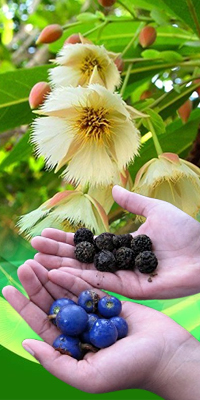Rudraksha beads are plant products which contain oxygen, carbon, nitrogen, hydrogen, and trace elements in combined form. The share compositions of their gaseous elements were determined by C-H-N Analyzer and by Gas Chromatography. The result shows that Rudraksha beads incorporate 50.031 activated charcoal, 30.53% oxygen, 0.95% nitrogen & 17.897% hydrogen. The Rudraksha tree could be a large evergreen broad-leaved tree. The scientific name of Rudraksha is Elaeocarpus ganitrus and the family is tiliaceae.

Where Rudraksha Grow
Geographically, Rudraksha is found growing naturally & abundantly in tropical and subtropical areas. The trees are perennial in habitat and are almost 50ft to 200ft tall. According to Shiva Purana, Rudraksha is the favourite of Lord Shiva. The Rudraksha trees grow in Gouda Land which in the present era is the area of the Gangetic Plain on the southern border area of Asia to the foothills of the nice Himalaya and middle area of Nepal. Thus, ranging from Manila, passing through Myanmar, plains likewise as low hills, its habitat extends to Bengal, Assam and adjoining north-eastern states, Bangladesh, Bhutan, Nepal. In the present era Rudraksha trees are basically localized in Nepal and also the southern part of Asia. Although Rudraksha are grown and located in Nepal, these are mainly localized to eastern a part of Nepal thanks to climatic suitability.

History of Rudraksha
Rudraksha Plant Elaeocarpus may be a large genus of evergreen trees. There are nearly 36 sister species, including Rudraksha of this plant. Generally, the trunk of the rudraksha tree is cylindrical and the section is circular. Bark is greyish white & prepares texture with small vertical lenticels and narrow horizontal furrows. The branches of the rudraksha tree spread altogether directions in such a way that when growing in natural habitat, the crown takes the form of a pyramid. The leaves of this tree are shining green above and dull coriaceous below. The flowers are ovoid, conical, elongate, nearly 1 to 2 cm in diameter. Usually these appear in April-May. The fruit is globose and drupaceous, having a fleshy exterior. The beads inside are hard and tubercle. The fruit starts appearing in June and ripens by August to October.
Farming of Rudraksha could be a difficult process because of its slow sprouting from the beads which usually takes about 1 to 2 years counting on the humidity of soil. Rudraksha is essentially grown in subtropical climatic regions with temperature ranges from 25 to 30 degree Centigrade. Once Rudraksha are planted it starts giving fruit after 7 years and thereafter for an extended time. Within a single tree beads come altogether different faces at the identical time but higher mukhis or faces are very rare to search out. Most Rudraksha beads are five faced and are available in seasonal pattern once a year around mid-august to mid-October from the tree. The Himalayan Beads simply seem to be larger, heavier and more powerful because of the environment they grow in. So it's a certainty that the environment and specifically the placement of the Rudraksha Trees play a key role in their growth. Rudraksha trees are easy to grow and once established, a rudraksha tree will last for years with a bit of care.

 Google has chosen Shaligram Shala ( shaligram.com) as the world's first 5 star
Google has chosen Shaligram Shala ( shaligram.com) as the world's first 5 star  rated Rudraksha supplying Company
rated Rudraksha supplying Company 

 Google has chosen Shaligram Shala ( shaligram.com) as the world's first 5 star
Google has chosen Shaligram Shala ( shaligram.com) as the world's first 5 star  rated Rudraksha supplying Company
rated Rudraksha supplying Company 


 Rudraksha as Found in Nature | Where Rudraksha Grow | History of Rudraksha
Rudraksha as Found in Nature | Where Rudraksha Grow | History of Rudraksha 















































